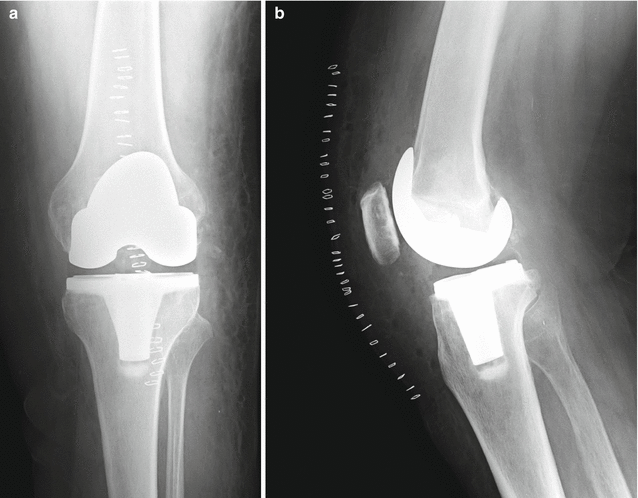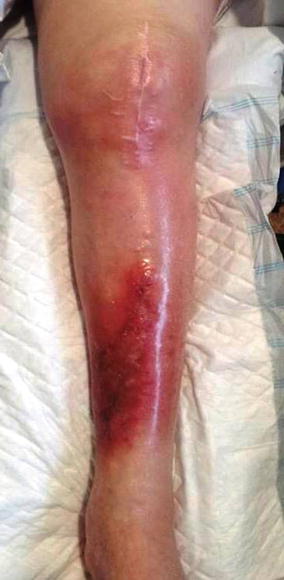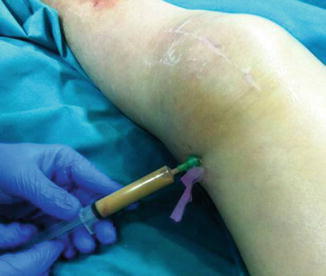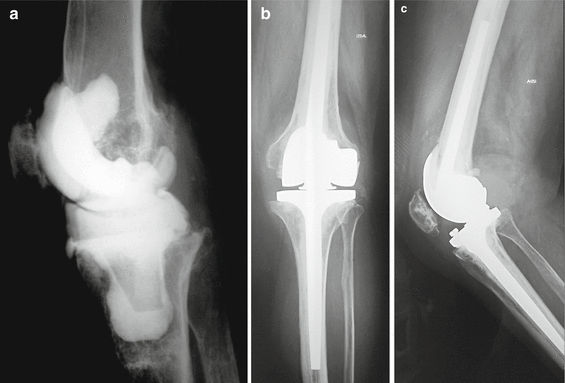
Fig. 3.1
Severe rheumatoid arthritis in a 78-year-old woman, affecting the hands (a, b), feet (c), and knees (d, e). A TKA of the left knee was indicated

Fig. 3.2
Post-operative pictures of the same patient of Fig. 3.1 (d, e) demonstrating a posterior-stabilised TKA with patellar resurfacing: (a) anteroposterior view. (b) Lateral radiograph

Fig. 3.3
Photograph of the same patient of Fig. 3.1 (d, e) 2 months following surgery demonstrating erythema secondary to prosthetic joint infection

Fig. 3.4
Arthrocentesis and culture confirmed the diagnosis of periprosthetic infection [same patient of Fig. 3.1 (d, e)]

Fig. 3.5
A two-stage revision arthroplasty was performed with a satisfactory result: an articulated spacer was implanted in the first stage of revision (a), and a rotating-hinge prosthesis was implanted in the second stage of revision (b, c) 3 months later same patient of Fig. 3.1 (d, e)
Overall implant survival appears to be similar in RA compared to OA. Several series exist for TKA in RA, demonstrating good overall survival [40, 55, 56]. The AOANJRR (Australian Orthopaedic Association National Joint Replacement Registry Annual Report) reports that survival (adjusted for age and gender) is superior in RA compared to OA (hazard ratio 0.66, 95 % confidence intervals 0.55–0.80, p < 0.001); this is the opposite of what the same registry reports for hip arthroplasty [45].
3.5.2 Other Inflammatory Arthropathies
Series related to other inflammatory arthropathies are uncommon. The AOANJRR reports that there is no difference in implant survival between OA and seronegative arthropathy [45]. Parvizi et al. [57] in 2001 published a series of 33 TKAs in patients with AS at a mean of 11.2 years following surgery. They reported excellent pain relief and only one revision (of a loose patellar component), but a high rate of heterotopic bone formation (6/33 knees, 20 %) and stiffness, with three patients requiring manipulation under anaesthetic. Stern et al. [58] in 1989 retrospectively reviewed 27 TKAs (in 18 patients) in patients with psoriasis at a single institution. They reported a high rate of deep infection (4/24 patients, 17 %) and of revision (21 % at 4 years). However, the inclusion criteria were broad – the authors do not classify any patient as having PA, but suggest that the patients had coexistent RA/OA and psoriasis – and all patients had active skin lesions at the time of surgery.
3.6 Conclusions
TKA in the presence of inflammatory arthropathy presents distinct challenges compared to cases with osteoarthritis (OA). Preoperative planning is of paramount importance to avoid anaesthetic and surgical complications, which are more prevalent in patients with inflammatory disease. Patients with RA may present with large amounts of bone loss, and soft tissue instability is often a major feature. As a result, posterior-stabilised designs are often preferred in rheumatoid arthritis (RA), as is patellar resurfacing (although the evidence for both conventions is limited). Patients with RA are at increased risk of infection and complications in general following TKA than those with OA. Overall survival appears to be similar in RA compared to OA. Patients with inflammatory arthropathy can benefit greatly from TKA, attaining excellent outcomes in terms of implant survival and post-operative function.
References
1.
National Joint Registry for England, Wales and Northern Ireland 11th annual report (2014)
2.
Australian Orthopaedic Association National Joint Replacement Registry annual report (2012). AOA, Adelaide, Australia
3.
The Swedish Knee Arthroplasty Register annual report (2013). Elvins Grafiska AB, Helsingborg, Sweden
4.
Goodfellow JW, O’Connor J (1986) Clinical results of the Oxford knee. Surface arthroplasty of the tibiofemoral joint with a meniscal bearing prosthesis. Clin Orthop Relat Res 205:21–42PubMed
5.
Gibbs AN, Green GA, Taylor JG (1979) A comparison of the Freeman-Swanson (ICLH) and Walldius prostheses in total knee replacement. J Bone Joint Surg Br 61:358–361PubMed
6.
Ranawat CS, Insall J, Shine J (1976) Duo-condylar knee arthroplasty: hospital for special surgery design. Clin Orthop Relat Res 120:76–82PubMed
7.
Singh JA, Lewallen DG (2014) Time trends in the characteristics of patients undergoing primary total knee arthroplasty. Arthritis Care Res (Hoboken) 66:897–906CrossRef
8.
9.
10.
Jamsen E, Virta LJ, Hakala M, Kauppi MJ, Malmivaara A, Lehto MU (2013) The decline in joint replacement surgery in rheumatoid arthritis is associated with a concomitant increase in the intensity of anti-rheumatic therapy. Acta Orthop 84:331–337PubMedCentralPubMedCrossRef
11.
Woolf AD, Pfleger B (2003) Burden of major musculoskeletal conditions. Bull World Health Organ 81:646–656PubMedCentralPubMed
12.
Helmick CG, Felson DT, Lawrence RC, Gabriel S, Hirsch R, Kwoh CK, Liang MH, Kremers HM, Mayes MD, Merkel PA, Pillemer SR, Reveille JD, Stone JH (2008) Estimates of the prevalence of arthritis and other rheumatic conditions in the United States. Part I. Arthritis Rheumatol 58:15–25CrossRef
13.
14.
Louie GH, Ward MM (2010) Changes in the rates of joint surgery among patients with rheumatoid arthritis in California, 1983–2007. Ann Rheum Dis 69:868–871PubMedCentralPubMedCrossRef
15.
Turesson C (2013) Extra-articular rheumatoid arthritis. Curr Opin Rheumatol 25:360–366PubMedCrossRef
Stay updated, free articles. Join our Telegram channel

Full access? Get Clinical Tree








